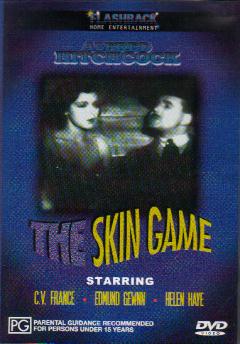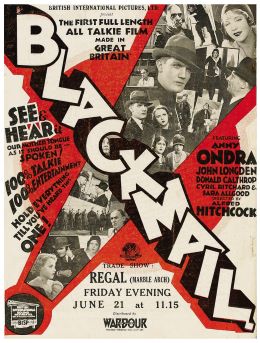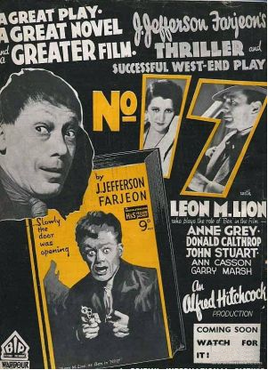
Sir Alfred Joseph Hitchcock was an English film director. He is widely regarded as one of the most influential figures in the history of cinema. In a career spanning six decades, he directed over 50 feature films, many of which are still widely watched and studied today. Known as the "Master of Suspense", Hitchcock became as well known as any of his actors thanks to his many interviews, his cameo appearances in most of his films, and his hosting and producing the television anthology Alfred Hitchcock Presents (1955–65). His films garnered 46 Academy Award nominations, including six wins, although he never won the award for Best Director, despite five nominations.

Young and Innocent, released in the US as The Girl Was Young, is a 1937 British crime thriller film directed by Alfred Hitchcock and starring Nova Pilbeam and Derrick De Marney. Based on the 1936 novel A Shilling for Candles by Josephine Tey, the film is about a young man on the run from a murder charge who enlists the help of a woman who must put herself at risk for his cause. An elaborately staged crane shot Hitchcock devised, which appears towards the end of the film, identifies the real murderer.

The Skin Game is a 1931 British drama film by Alfred Hitchcock, based on the 1920 play by John Galsworthy and produced by British International Pictures. The story revolves around two rival families, the Hillcrists and the Hornblowers, and the disastrous results of the feud between them.

The Paradine Case is a 1947 courtroom drama with elements of film noir set in England, directed by Alfred Hitchcock and produced by David O. Selznick. Selznick and an uncredited Ben Hecht wrote the screenplay from an adaptation by Alma Reville and James Bridie of the 1933 novel by Robert Smythe Hichens. The film stars Gregory Peck, Ann Todd, Alida Valli, Charles Laughton, Charles Coburn, Ethel Barrymore, and Louis Jourdan. It tells of an English barrister who falls in love with a woman who is accused of murder, and how it affects his relationship with his wife.

The Lodger: A Story of the London Fog is a 1927 British silent thriller film directed by Alfred Hitchcock and starring Marie Ault, Arthur Chesney, June Tripp, Malcolm Keen and Ivor Novello. Hitchcock's third feature film, it was released on 14 February 1927 in London and on 10 June 1928 in New York City. The film is based on the 1913 novel The Lodger by Marie Belloc Lowndes and the play Who Is He? co-written by Belloc Lowndes. Its plot concerns the hunt for a Jack the Ripper-like serial killer in London.

The Mountain Eagle is a 1926 silent drama film, and Alfred Hitchcock's second as director, following The Pleasure Garden. The film, a romantic melodrama set in Kentucky, is about a widower who jealously competes with his crippled son and a man he loathes over the affections of a schoolteacher. The film was mostly produced at the Emelka Film studios in Munich, Germany in autumn of 1925, with exterior scenes shot in the village of Obergurgl in the State of Tyrol, Austria. Production was plagued with problems, including the destruction of a village roof and Hitchcock experiencing altitude sickness. Due to producing the film in Germany, Hitchcock had more directorial freedom than he would have had in England, and he was influenced by German cinematic style and technique.

Blackmail is a 1929 British thriller directed by Alfred Hitchcock and starring Anny Ondra, John Longden, and Cyril Ritchard. Based on the 1928 play of the same name by Charles Bennett, the film is about a London woman who is blackmailed after killing a man who tries to rape her.

Waltzes from Vienna is a 1934 British biographical film directed by Alfred Hitchcock, sometimes known as Strauss' Great Waltz. It was part of the cycle of operetta films made in Britain during the 1930s.

The Ring is a 1927 British silent romance film written and directed by Alfred Hitchcock and starring Carl Brisson, Lillian Hall-Davis and Ian Hunter.

Downhill is a 1927 British silent drama film directed by Alfred Hitchcock, starring Ivor Novello, Robin Irvine and Isabel Jeans, and based on the play Down Hill by Novello and Constance Collier. The film was produced by Gainsborough Pictures at their Islington studios. Downhill was Hitchcock's fourth film as director, but the fifth to be released. Its American alternative title was When Boys Leave Home.

Number Seventeen is a 1932 British comedy thriller film directed by Alfred Hitchcock and starring John Stuart, Anne Grey and Leon M. Lion. The film, which is based on the 1925 burlesque stage play Number Seventeen written by Joseph Jefferson Farjeon, concerns a group of criminals who commit a jewel robbery and hide their loot in an old house over a railway leading to the English Channel. The film's title is derived from the house's street number.
Champagne is a 1928 British silent comedy film directed by Alfred Hitchcock and starring Betty Balfour, Gordon Harker and Jean Bradin. The screenplay was based on an original story by writer and critic Walter C. Mycroft. The plot concerns a young woman forced to take a job after her father loses his fortune.

The Man Who Knew Too Much is a 1934 British spy thriller film directed by Alfred Hitchcock, featuring Leslie Banks and Peter Lorre, and released by Gaumont British. It was one of the most successful and critically acclaimed films of Hitchcock's British period.

Mary (1931) is a British-German thriller film, directed by Alfred Hitchcock, and is the German-language version of Hitchcock's Murder! (1930), shot simultaneously on the same sets with German-speaking actors. The film is based on the 1928 book Enter Sir John by Clemence Dane and Helen Simpson, and stars Alfred Abel and Olga Chekhova. Miles Mander reprises his role as Gordon Druce from Murder!, though the character's name was changed to Gordon Moore.

Jamaica Inn is a 1939 British adventure thriller film directed by Alfred Hitchcock and adapted from Daphne du Maurier's 1936 novel of the same name. It is the first of three of du Maurier's works that Hitchcock adapted. It stars Charles Laughton and Maureen O'Hara in her first major screen role. It is the last film Hitchcock made in the United Kingdom before he moved to the United States.

Norah Baring, born Nora Minnie Baker, was an English stage and film actress best known on screen for portraying "Diana Baring" in the Alfred Hitchcock thriller Murder! (1930).

Juno and the Paycock is an all-talking sound 1930 British tragicomedy film written and directed by Alfred Hitchcock, and starring Barry Fitzgerald, Maire O'Neill, Edward Chapman and Sara Allgood.

Edward Chapman was an English actor who starred in many films and television programmes, but is chiefly remembered as "Mr. William Grimsdale", the officious superior and comic foil to Norman Wisdom's character of Pitkin in many of his films from the late 1950s and 1960s.

Phyllis Esther Kohnstamm, known as Phyllis Konstam, was an English film actress born in London. She appeared in 12 films between 1928 and 1964, including four directed by Alfred Hitchcock.

Enter Sir John is a 1928 British crime novel by Clemence Dane and Helen Simpson. It concerns Martella Baring, a young actress, who is put on trial and convicted of murder and a fellow actor Sir John Saumarez who takes up her cause and tries to prove her innocence. It was followed by the sequel Re-enter Sir John in 1932.


















